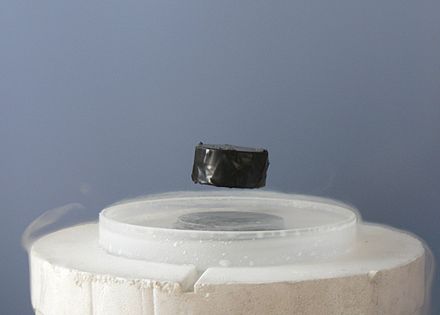Generating entangled photons by linking LEDs and superconductors
March 31, 2014

A magnet levitating above a high-temperature superconductor, cooled with liquid nitrogen (credit: Wikimedia Commons)
A team of University of Toronto physicists led by Alex Hayat has proposed a novel and efficient way to leverage quantum entanglement: combining light-emitting diodes (LEDs) with a superconductor to generate entangled photons.
The method could open up a rich spectrum of new physics as well as devices for quantum technologies, including quantum computers and quantum communication, the researchers suggest.
“A usual light source such as an LED emits photons randomly without any correlations,” explains Hayat, who is also a Global Scholar at the Canadian Institute for Advanced Research. “We’ve proved that generating entanglement between photons emitted from an LED can be achieved by adding another peculiar physical effect of superconductivity — a resistance-free electrical current in certain materials at low temperatures.”
Cooper pairs
This effect occurs when electrons are entangled in Cooper pairs — a phenomenon in which when one electron spins one way, the other will spin in the opposite direction. When a layer of such superconducting material is placed in close contact with a semiconductor LED structure, Cooper pairs are injected in to the LED, so that pairs of entangled electrons create entangled pairs of photons. The effect, however, turns out to work only in LEDs that use nanometer-thick active regions — quantum wells.
According to Wikipedia, “the Cooper pair state is described in the BCS theory developed by John Bardeen, Leon Cooper, and John Schrieffer for which they shared the 1972 Nobel Prize.”
“Typically quantum properties show up on very small scales — an electron or an atom,” Hayat said. “Superconductivity allows quantum effects to show up on large scales — an electrical component or a whole circuit. This quantum behavior can significantly enhance light emission in general, and entangled photon emission in particular.”
New light on superconductivity too
“Quantum light sources based on LED combined with a superconductor would emit entangled photon pairs for quantum information and quantum communication applications, as well as for basic research in quantum physics and superconductors,” Hayat explained to KurzweilAI in an email interview. “Numerous quantum computing schemes and quantum communication protocols employ entangled photons. Thus a compact and efficient source of entanglement can be very useful.
“Moreover, the quantum properties of light emitted from such superconducting LEDs can shed new light on the phenomenon of superconductivity itself. The tools available in quantum optics allow full characterization of quantum states, e.g., by quantum tomography. This can open a new quantum optical window into the studies of superconductivity — especially in novel materials which are still not fully understood like cuprates and iron-based materials.
“What makes this approach so useful is the fact that the devices are compact and electrically driven — an LED basically. Existing techniques to generate entangle photons are mainly by nonlinear optical process of parametric downconversion, which requires bulky optical setups and strong and expensive lasers.
“Also, this approach is much more efficient, due to the superconducting enhancement of the emission. Most previous photon-pair generation approaches are based on second-order processes, which are typically 4–5 orders of magnitude weaker than the regular one-photon emission. E.g., we measured two-photon emission in semiconductors: Nature Photon. 2, 238 (2008). With the superconducting enhancement, the one-photon and the two-photon emission rates were measured to be nearly equal (Phys. Rev. Lett. 107, 157403). Therefore the superconducting enhancement should be as strong as several orders of magnitude.”
The research was published in Physical Review B, an international journal specializing in condensed-matter phenomena and materials physics on March 10.
Abstract of Physical Review B paper
We show that the recombination of Cooper pairs in semiconductors can be used as a natural source of polarization-entangled photons, making use of the inherent angular momentum entanglement in the superconducting state. Our proposal is not based on opposite spin population of discrete energy levels and thus does not require isolated emitters such as single atoms or quantum dots. We observe that in bulk materials, the photon entanglement would be degraded due to the variety of decay channels available in the presence of light-hole (LH)–heavy-hole (HH) degeneracy. However, we show that the lifting of this degeneracy by use of a semiconductor quantum well should lead to faithful conversion of the Cooper-pair entanglement into photon entanglement. The second-order decay of two-electron states in Cooper-pair luminescence leaves no which-path information, resulting in perfect coherence between two pathways and hence, in principle, perfect entanglement. We calculate the purity of the entangled-photon state and find that it increases for larger LH–HH energy splitting and for lower temperatures. Moreover, the superconducting macroscopic coherence offers an enhancement to the emission rate, making this a promising scheme for efficient generation of entangled photons in simple electrically driven structures.